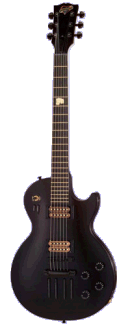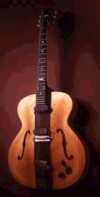Acoustic Guitar Electric Guitar Lessons
Guitar Types
Acoustic Guitar Parts
Electric Guitar Parts
Acoustic or Electric Guitar
Buy Acoustic Guitar
Buy Electric Guitar
Basic Guitar Lessons
Guitar Notes
Guitar Chords
Guitar Tabs
Guitar Sheet Music
Guitar Techniques
Acoustic Guitar Types
Electric Guitar Types
Electric Guitar Effects
Electric Guitar Amps
Guitar Care
Child Guitar
|
Electric Guitar Effects
All present western music (rock, jazz, R&B, rap, etc) has evolved from blues, and the ability to alter the sounds of an electric guitar have been passed on to each new genre. Heavy metal, for example, almost exclusively uses the Distortion effect with electric guitars. The distortion effect does exactly what its name suggests, it distorts the original guitar sound and produces a completely new sound - bordering on screeching. Jimi Hendrix has created mind bending wails from his guitar with distortion. Many amps today have distortion effects built in, it is a very popular effect used in rock and blues music. While many variations of distortion exist, most are are "Gain" control effects. Two controls, "Pre-Gain" and "Post-Gain", alter the sound on the pre and post edge of the sound wave. This can create sounds ranging from a flat "thunk" (bluesy), to a screeching "wail" (metal).
To read the next page, click the link marked Next>>> below.
|
|||||
Content and materials on this website are Copyright ©2006-2025 4PlayGuitar.com.
Access to this website and content is provided with no guarantees, and we are not
liable for any damages, consequential or inconsequential, from the ability or
disability of using this website. Use these materials at your own risk.
Usage of this website constitutes acknowledgment of these disclaimers
and terms. View our Privacy Statement.

 When Les Paul invented the first solid body electric guitar in the 1950's - blues musicians immediately embraced the new contraption. Since electric guitars require an amplifier (amp) to produce the sound, it is an easy matter to electronically alter the signal to change the sound. They recognized the possibilities of being able to make funky sounds with it. Click for
When Les Paul invented the first solid body electric guitar in the 1950's - blues musicians immediately embraced the new contraption. Since electric guitars require an amplifier (amp) to produce the sound, it is an easy matter to electronically alter the signal to change the sound. They recognized the possibilities of being able to make funky sounds with it. Click for  The Wah Wah effect was made popular during the sixties by bands such as Cream. The Wah Wah effect is activated by the guitarist's foot (by rocking the effect pedal), and alters the tone of the sound (going from low treble to high treble) - this creates a voice-like wah-wah-wah effect. New digital wah wah effects devices also have "Auto Wah", in which no pedal pressing is required - the computer in the device automatically varies the sound for you. Some popular rock songs use a wah wah pedal, but it is kept stationary in halfway position - this makes a unique funky sound. Many other effects are also available; such as producing an acoustic guitar sound from an electric guitar pickups, signal duplication (sounds like two guitars are playing), rotating speaker modelling (mimics rotating cone speakers used by some musicians), and many more effects.
The Wah Wah effect was made popular during the sixties by bands such as Cream. The Wah Wah effect is activated by the guitarist's foot (by rocking the effect pedal), and alters the tone of the sound (going from low treble to high treble) - this creates a voice-like wah-wah-wah effect. New digital wah wah effects devices also have "Auto Wah", in which no pedal pressing is required - the computer in the device automatically varies the sound for you. Some popular rock songs use a wah wah pedal, but it is kept stationary in halfway position - this makes a unique funky sound. Many other effects are also available; such as producing an acoustic guitar sound from an electric guitar pickups, signal duplication (sounds like two guitars are playing), rotating speaker modelling (mimics rotating cone speakers used by some musicians), and many more effects.